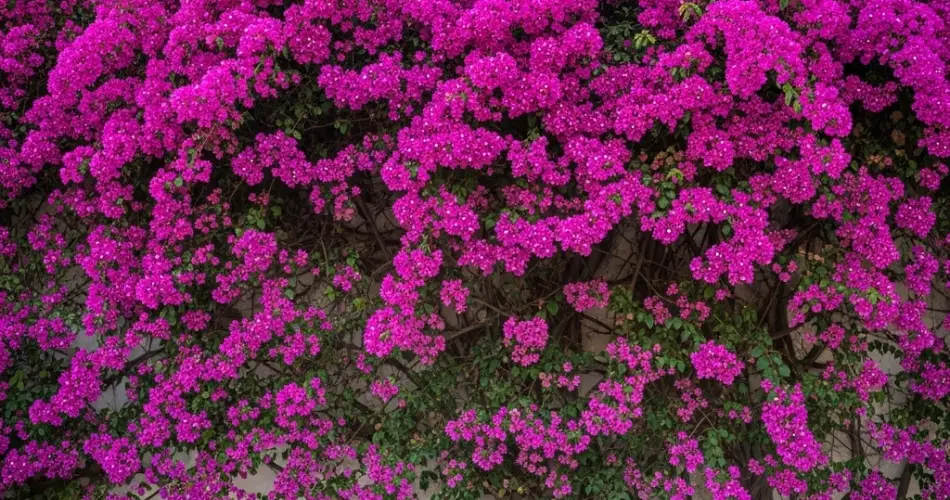Bougainvillea is admired for its vibrant, papery bracts and fast-growing nature. Whether climbing over fences or cascading from containers, this tropical favorite brings stunning color to any garden. However, despite its hardy nature, bougainvillea can experience problems that affect its growth, flowering, and overall health. The good news is that many of these issues can be managed with natural solutions that avoid harsh chemicals and support a healthy garden environment.
This article explores the most common problems bougainvillea growers face and offers practical, natural remedies to resolve them.
1. Bougainvillea Not Flowering
One of the most common concerns among bougainvillea owners is a lack of blooms. While the plant is known for its brilliant bracts, it won’t flower well if certain conditions aren’t met.
Possible Causes:
-
Too much nitrogen from over-fertilizing
-
Insufficient sunlight
-
Excessive watering
-
Lack of pruning
Natural Solutions:
-
Reduce watering and allow the soil to dry out between waterings. Bougainvillea blooms best when slightly stressed.
-
Ensure full sun exposure—at least 6 hours of direct sunlight daily is essential.
-
Use low-nitrogen fertilizer, such as a 5-10-10 organic mix, to encourage flowering instead of foliage growth.
-
Prune lightly after flowering to encourage new growth and more blooms.
2. Leaf Drop
Bougainvillea may shed leaves suddenly, especially when it’s stressed or experiencing a change in environment.
Possible Causes:
-
Sudden temperature shifts
-
Transplant shock
-
Overwatering or underwatering
-
Poor drainage
Natural Solutions:
-
If transplanting, water the plant deeply but infrequently and avoid disturbing the roots.
-
Improve drainage by amending the soil with sand or compost if it’s too compact or heavy.
-
Keep the plant in a consistent temperature range, especially if grown in pots.
-
Avoid overwatering—let the soil dry out between waterings, especially in cooler months.
3. Yellow Leaves
Yellowing leaves on bougainvillea can be a sign of multiple issues, including nutrient deficiency, poor drainage, or pests.
Possible Causes:
-
Iron or magnesium deficiency
-
Overwatering
-
Root rot
-
Poor soil drainage
Natural Solutions:
-
Apply chelated iron or Epsom salts (magnesium sulfate) to correct deficiencies—dissolve a tablespoon in a gallon of water and apply to the soil.
-
Ensure proper drainage in containers and garden beds.
-
Use compost or worm castings to enrich the soil with natural nutrients.
-
Cut back on watering and let the soil dry before the next session.
4. Pest Infestations
Bougainvillea is relatively pest-resistant, but it can occasionally be affected by aphids, caterpillars, mealybugs, or spider mites.
Common Signs:
-
Sticky residue or curled leaves (aphids)
-
White cottony masses (mealybugs)
-
Fine webbing and stippled leaves (spider mites)
-
Holes in leaves (caterpillars)
Natural Solutions:
-
Spray neem oil or insecticidal soap once a week until pests are gone.
-
Introduce beneficial insects like ladybugs or lacewings to control aphid populations.
-
For mealybugs, use a cotton swab dipped in rubbing alcohol to remove them manually.
-
Regularly hose down the plant with water to dislodge pests and clean the leaves.
5. Root Rot
Root rot is caused by consistently wet soil, which suffocates roots and promotes fungal growth.
Symptoms:
-
Wilting despite moist soil
-
Yellowing leaves
-
Stunted growth
-
Blackened, mushy roots when examined
Natural Solutions:
-
Remove the plant from soggy soil and trim away affected roots.
-
Repot using well-draining soil, such as a cactus or succulent mix.
-
Water only when the top inch of soil is dry.
-
Add beneficial microbes or mycorrhizal fungi to the soil to improve root health.
6. Fungal Diseases
In humid or poorly ventilated conditions, bougainvillea may develop fungal issues like powdery mildew or leaf spot.
Symptoms:
-
White, powdery residue on leaves
-
Dark spots or blotches
-
Leaf curling and premature dropping
Natural Solutions:
-
Improve air circulation by spacing plants properly and pruning dense areas.
-
Spray a mixture of baking soda and water (1 teaspoon baking soda per quart of water) as a natural antifungal treatment.
-
Use compost tea or diluted apple cider vinegar as an organic spray to suppress fungal growth.
7. Leggy or Sparse Growth
Bougainvillea can become leggy if it isn’t pruned regularly or isn’t receiving enough light.
Natural Solutions:
-
Prune the plant after each blooming cycle to encourage branching and fuller growth.
-
Pinch back new shoots to promote bushiness.
-
Relocate to a sunnier spot if it’s not getting enough light.
Final Thoughts
Bougainvillea is a tough and beautiful plant, but even the hardiest species need proper care to thrive. By identifying common problems early and using natural solutions, you can keep your bougainvillea vibrant and blooming throughout the season. Whether in containers, on trellises, or in garden beds, a healthy bougainvillea adds stunning color and charm to any outdoor space—naturally and chemical-free.



